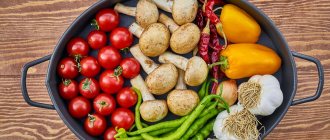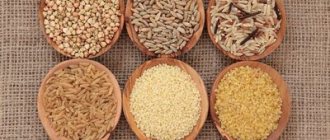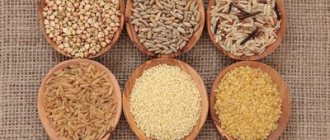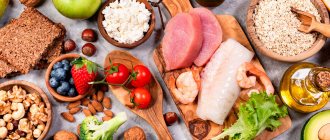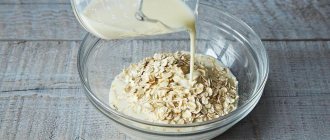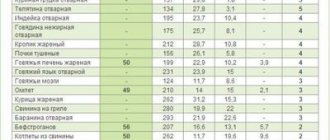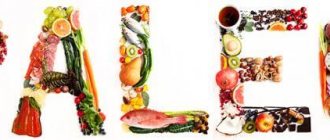The glycemic index (abbreviated as GI) is a value that reflects the effect of carbohydrates in food on blood glucose levels. For diseases of the pancreas, including pancreatitis, diabetes mellitus and others, the glycemic index of foods should be low, since in this case there is no increase in the activity of the organ. This can affect the well-being of people with pancreatic dysfunction: pain, digestive problems, and increased blood sugar. In addition, foods with a low glycemic index are useful for preventing the onset of chronic diseases and maintaining normal or reducing excess weight.
What is the glycemic index of foods?
The glycemic index of foods (GI) is a measure of the rate at which glucose rises in the body after eating a particular food. To fully understand this definition, we can characterize this process. Carbohydrates represent the most important energy value. They can be complex and determined by the number of intermolecular bonds (polysaccharides) and simple (disaccharides, monosarides). When complex carbohydrates and other nutrients enter the body under the influence of enzymes, they are broken down into simple ones, and simple ones under the influence of chemical reactions into glucose.
The higher the rate of breakdown, the more glucose is produced and the blood sugar level rises. These are high glycemic index foods. At low speed, breakdown products are retained for a long time and are absorbed more slowly. This gives a feeling of fullness for quite a long time and for weight loss, as well as people suffering from diabetes, this low index will be the most optimal.
The concept of glycemic index was introduced in 1981 at the Canadian University of Toronto by scientific doctor David Jenkins. For this purpose, special experiments were carried out, during which volunteers were given food containing 50 g of carbohydrates. Then, for an hour, every 15 minutes, a blood test was taken and the blood sugar level was determined. Based on the data obtained, special graphs were constructed, and the experiments continued. When it was possible to obtain all the necessary data, the concept and definition itself was introduced. However, this value is a relatively relative unit, the essence of which is to compare products with pure glucose, which has a 100% glycemic index.
When the question arises, what is the difference between the concepts of “calorie content” and “glycemic index”, the answer is as follows. GI is a display of the rate of breakdown of carbohydrates into glucose and the degree of increase in blood sugar, and calorie content is only the amount of energy value obtained from food intake.
Expert opinion
According to colleagues who focus on AI and GI indicators, the first step to losing weight should be adjusting your diet. With a properly balanced diet, a person consumes more foods with low indexes. Healthy foods that contain a lot of carbohydrates and sugar should be consumed in the morning. During the day, it is advisable to eat dishes with medium and low AI/GI indicators. For evening snacks and dinner, products with minimal indexes are selected. By adhering to a well-designed “nutrition map”, a person gets rid of excess weight easily and quickly, without experiencing discomfort and without harming his health.
Glycemic index table
In order to have an idea of the rate of breakdown of carbohydrates in a particular dish, a special table has been created, where each product has its own glycemic index value. It was created to provide information specifically for each food product, at what speed the body breaks down its carbohydrates into glucose.
This data is important for people who adhere to a properly balanced diet, as well as those suffering from diabetes. According to established data, tables with GI have approximate values, and the indicators themselves refer to one specific product without any thermal or mechanical treatment in its entirety. There are 3 groups of glycemic index foods:
- low (from 0 to 40);
- average (from 40-70);
- high (70 or more).
The table does not contain low-fat cheeses and dairy products, broths, or water. This is due, first of all, to the fact that their glycemic index is practically zero.
Low GI
| Product name | GI |
| Oysters, shrimp, mussels, soy sauce | 0 |
| Spices, seasonings | 5 |
| Cancers | 5 |
| Avocado | 10 |
| Peanut | 15 |
| Brussels sprouts | 15 |
| Broccoli | 15 |
| Mushrooms | 15 |
| Walnuts | 15 |
| Green bean | 15 |
| Ginger | 15 |
| Zucchini | 15 |
| Sauerkraut | 15 |
| Cauliflower | 15 |
| Pine nuts | 15 |
| Red bell pepper | 15 |
| Onion | 15 |
| Hazelnuts | 15 |
| Olives | 15 |
| Almond | 15 |
| cucumbers | 15 |
| Radish | 15 |
| Rhubarb | 15 |
| Leaf salad | 15 |
| Celery | 15 |
| Black currant | 15 |
| Dill | 15 |
| Pistachios | 15 |
| Hazelnut | 15 |
| Spinach | 15 |
| Bitter chocolate with cocoa content less than 85% | 20 |
| Yogurt not flavored | 20 |
| Lemon juice | 20 |
| Cocoa powder | 20 |
| Barbados cherry | 20 |
| Eggplant | 20 |
| Artichoke | 20 |
| Peas | 25 |
| Blackberry | 25 |
| Strawberries | 25 |
| Gooseberry | 25 |
| Strawberry | 25 |
| Raspberries | 25 |
| Beans | 25 |
| Red currants | 25 |
| Blueberry | 25 |
| Cherries | 25 |
| Barley grits | 25 |
| Lentils | 30 |
| Garlic | 30 |
| Beet | 30 |
| Turnip | 30 |
| Tomatoes | 30 |
| Pomelo | 30 |
| Carrot | 30 |
| Milk | 30 |
| Marmalade | 30 |
| passion fruit | 30 |
| Tangerines | 30 |
| Dried apricots | 30 |
| Pears | 30 |
| Grapefruit | 30 |
| Apricots | 35 |
| Oranges | 35 |
| Quince | 35 |
| Pomegranate | 35 |
| Mustard | 35 |
| Yeast | 35 |
| Green pea | 35 |
| Sunflower grains | 35 |
| Yogurt | 35 |
| Celery root | 35 |
| Sesame | 35 |
| Corn | 35 |
| Poppy | 35 |
| Nectarine | 35 |
| Peaches | 35 |
| Wild rice | 35 |
| Sunflower seeds | 35 |
| Plums | 35 |
| Fructose ice cream | 35 |
| Tomato juice | 35 |
| Canned peas | 35 |
| Red and black beans | 35 |
| Whole grain and sprouted grain bread | 35 |
| Apple | 35 |
Average GI
| Product name | GI |
| Dry beans | 40 |
| Buckwheat | 40 |
| carrot juice | 40 |
| Cereals | 40 |
| Spaghetti made from wheat flour | 40 |
| Chicory | 40 |
| Bananas | 45 |
| Grape | 45 |
| Vermicelli | 45 |
| Grapefruit juice | 45 |
| Jam | 45 |
| Coconut | 45 |
| Cranberry | 45 |
| Bread | 45 |
| A pineapple | 50 |
| Jam | 50 |
| Figs | 50 |
| Kiwi | 50 |
| Crab sticks | 50 |
| Orange juice | 50 |
| Mango | 50 |
| Durum pasta | 50 |
| Muesli | 50 |
| Canned peaches | 50 |
| Jam | 50 |
| Unpeeled rice | 50 |
| Ground pear | 50 |
| Blueberry juice | 50 |
| Apple juice | 50 |
| Persimmon | 50 |
| Canned peaches | 55 |
| Rolls and sushi | 55 |
| Mustard | 55 |
| Ketchup | 55 |
| Grape juice | 55 |
| Canned corn | 55 |
| Melon | 60 |
| Papaya | 60 |
| Cocoa with added sugar | 60 |
| Oatmeal | 60 |
| Ice cream | 60 |
| Long grain rice | 60 |
| Industrial mayonnaise | 60 |
| Melon | 60 |
| Lasagna | 60 |
| Wheat flour pancakes | 60 |
| Pizza with cheese and tomatoes | 60 |
| Pasta with cheese | 65 |
| Boiled jacket potatoes | 65 |
| Sorbet | 65 |
| Rye bread | 65 |
| Canned vegetables | 65 |
| Maple syrup | 65 |
| Raisin | 65 |
| Muesli with sugar | 65 |
| Marmalade | 65 |
| Boiled beets | 65 |
| Yeast black bread | 65 |
| Jam | 65 |
High GI
| Products name | GI |
| Wheat flour | 70 |
| Sugar | 70 |
| Semolina | 70 |
| Potato chips | 70 |
| Croissant | 70 |
| Pearl barley | 70 |
| Chocolate bars (Mars, Twix, Snickers, etc.) | 70 |
| Sweet sparkling water | 70 |
| Milk chocolate | 70 |
| Millet | 70 |
| Unsweetened waffles | 75 |
| Rice porridge with milk and sugar | 75 |
| Watermelon | 75 |
| French baguette bread | 75 |
| Zucchini | 75 |
| Pumpkin | 75 |
| Cornflakes | 75 |
| Sweet donut | 75 |
| Cracker | 80 |
| Mashed potatoes | 80 |
| Muesli with raisins and nuts | 80 |
| Unsweetened popcorn | 85 |
| Hamburger buns | 85 |
| Cornflakes | 85 |
| Rice pudding with milk | 85 |
| Boiled carrots | 85 |
| Instant mashed potatoes | 85 |
| Canned apricots | 90 |
| Rice noodles | 90 |
| White bread | 90 |
| Fried potatoes | 95 |
| Butter buns | 95 |
| baked potato | 95 |
| Potato casserole | 95 |
| Toast made from white bread | 100 |
| Glucose | 100 |
| Modified starch | 100 |
| Dates | 105 |
| Beer drinks | 110 |
What is the GI of vegetables?
Potatoes
The glycemic index of potatoes is high regardless of heat treatment:
- fried potatoes - 95;
- baked - 70;
- mashed potatoes - 90;
- potato chips - 85;
- jacket potatoes - 65.
Vinaigrette is a more preferable dish for patients than potato tubers in their pure form.
Experienced patients know that to reduce the indicator it is necessary to cook the whole root vegetable: this way the chains are not destroyed. With this method of preparation, the GI is reduced by 10-15 units. It is also important to consider the calorie content of the finished product: boiled potatoes - 82 kcal, fresh - 79 kcal, fried - 193 kcal, chips - 280 kcal per 100 grams. If you have diabetes, you need to limit the amount of potatoes, and it is better to eat them in combination with other vegetables, for example, in a vinaigrette.
Cucumber index
Cucumber juice is a preventative against the following diseases:
- hypertension;
- overweight;
- tuberculosis;
- inflammation of the gums
Cucumber seeds reduce bad cholesterol levels, have a mild laxative effect, and contain Ca, Mn, Se, Ag, Fe. These vegetables saturate and quench thirst well, so they are irreplaceable on hot summer days. Cucumber has a low GI - 10 units, however, in case of some diseases, this vegetable will have to be abandoned:
- colitis;
- hepatitis;
- cholecystitis;
- kidney diseases;
- acute gastritis and stomach ulcer.
Return to contents
Glycemic index of cabbage
The GI value of cabbage is 15 units. The peculiarity of this vegetable is that it maintains its GI level regardless of the cooking method. White cabbage contains fiber, vitamins C, B, K, P, E, U. Cabbage is very filling for diabetes, helps with excess weight, and is used to prevent gastrointestinal and liver diseases.
In case of exacerbation of gastrointestinal diseases, pancreatitis or cholecystitis, cabbage is excluded from the diet.
Pumpkin and diabetes
Pumpkin contains:
- macroelements: Fe, Mg, Ca, K;
- vitamins: A, C, D, E, F, PP.
According to the table of glycemic indexes, the pumpkin index is 75 units, pumpkin juice - 70. Pumpkin juice strengthens the immune system, has a laxative effect, helps with toxicosis, and removes toxins. Dishes with pumpkin are contraindicated for people with low acidity of gastric juice, with a tendency to colic, flatulence and bloating.
Radish for diabetes
- facilitates the course of ischemia, gout, rheumatism;
- prevents heart attack and stroke;
- helps normalize metabolism.
Radish is rich in natural insulin, which helps improve the patient's condition.
The glycemic index of radish is 15 units. An important property of this vegetable is that it contains natural insulin, which reduces the load on the pancreas, which is very important for high sugar levels. In addition, thanks to anthocyanin, radishes are a strong preventive agent against the development of cancer. Contraindications for use:
- chronic gastrointestinal diseases;
- metabolic disease;
- pathological processes in the liver and kidneys;
- thyroid disease.
Return to contents
Beetroot and diabetes
The calorie content of raw beets is 40 kcal. The vegetable is useful for vitamin deficiency and anemia, hypertension, gum disease, atherosclerosis and slagging in the body. Fiber and organic acids improve intestinal function and relieve constipation. For diabetes, healthy salads are often made from it and beetroot soup is cooked. It is not added to food for kidney stones, since beets aggravate the course of the disease. The glycemic index of beets is 30 units.
GI of zucchini
Zucchini is low in calories - 25 kcal, glycemic index - 15 units. After frying, zucchini has a GI of 75 units, so it is better to pickle them, stew them, or eat them in the form of zucchini caviar. Useful properties of zucchini:
- Vitamin C strengthens the walls of blood vessels, normalizes blood circulation and strengthens the immune system;
- folic acid improves the condition of the central nervous system;
- retinol improves the condition of the visual organs;
- calcium strengthens bones;
- thiamine and pyridoxine stabilize the functioning of the nervous system;
- zinc enhances regeneration processes in the skin.
Return to contents
Carrot GI
The glycemic index of carrots is 35. This is in its raw form. Boiled carrots have 85 units. Carrots contain:
The root vegetable contains many useful substances.
- minerals: K, P, Mg, Co, Cu, I, Zn, Cr, Ni, F;
- vitamins: K, E, C, PP, B.
The beneficial properties of this vegetable help improve the condition of the body. Diabetics often have to treat concomitant diseases, and the positive effect of nutrients supplied with food is very important. Benefits of carrots:
- strengthens the retina;
- improves gum condition;
- facilitates the course of liver diseases and anemia;
- strengthens the walls of blood vessels;
- helps with kidney diseases.
Return to contents
Tomato and diabetes
- GI - 10;
- XE - 0.33;
- calorie content - 20 kcal.
Tomato juice is allowed for consumption in the menu of people with high blood sugar levels.
Tomatoes compete with citrus fruits in terms of ascorbic acid content, are rich in anthocyanins, strengthen the immune system, and accelerate the healing of wounds and cuts. Tomato juice is healthy and nutritious; if you have diabetes, you can drink it all year round. Useful properties of tomatoes:
- improve the production of gastric juice;
- strengthen the nervous system;
- are a preventative against cancer and osteoporosis;
- improve skin condition.
Return to contents
What determines the glycemic index of foods?
Products are not always consumed individually and fresh. When preparing dishes and other mechanical effects on food, the level of absorption of carbohydrates changes. So, for what reasons does the glycemic index of foods in a finished dish change:
- Adding flavored additives and sugar to food increases the GI.
- Total fiber content. Fiber has the ability to slow down digestion and the flow of glucose into the circulatory system.
- Product processing method. Structured foods that require a lot of chewing have a lower GI, for example, raw vegetables are better in this case than boiled ones. Products subject to mechanical or heat treatment increase the index.
- Fruits and vegetables of greater ripeness increase the GI index.
- The method of cooking is also an important indicator. Grain bread will have a lower GI value than cooked fluffy wheat bread.
- The more food is crushed during cooking, the more the glycemic index increases. For example, the GI value of a peach will be lower in its whole form than if consumed as peach juice.
However, in addition to these factors, the individual characteristics of the human body are also taken into account. The response to low or high GI foods may depend on:
- age;
- ecology where people live;
- metabolic states;
- state of the immune system;
- the presence of infectious or inflammatory diseases in the body;
- from medications taken that can affect the rate of protein breakdown;
- on the amount of physical activity.
With the gradual introduction of foods with low or medium GI into your usual diet, you can edit and arrange your usual foods for better digestibility, based on your personal characteristics of the body.
Other vegetables
People do not always like vegetables, trying to use low GI fruits in their diet. They are also healthy, but due to the sugar they contain, it is recommended to limit the amount of fruit after noon. During this period, it is better to replace the tangerine with fresh carrots or several leaves of green cabbage. Doctors recommend that you always keep tables with the GI values of frequently consumed foods in a visible place. This will help you avoid mistakes when planning your diet. The table shows the GI of the most commonly consumed vegetables.
GI level
| Vegetable | Indicator, units | |
| Short | Boiled beans | 40 |
| Eggplant caviar | ||
| Raw green peas | ||
| Carrot | 35 | |
| Garlic | 30 | |
| Boiled lentils | 25 | |
| Sweet potato | 18 | |
| Spinach, cauliflower, asparagus | 15 | |
| Braised cabbage | ||
| Zucchini | ||
| Broccoli | ||
| Celery | ||
| Avocado | 19 | |
| Tomatoes, onions | 12 | |
| bell pepper | 18 | |
| Eggplant | 22 | |
| Average | Boiled corn | 70 |
| Stewed zucchini | 64 | |
| Boiled beets | ||
| Stewed potatoes | 65 | |
| High | Baked potatoes | 70 |
| Baked pumpkin | 74 | |
| Fried potato | 90 |
Glycemic index and diabetes mellitus
Diabetes mellitus is a disease in which control of blood sugar levels is impaired. If in a healthy person, when eating foods with a high GI, excess glucose is distributed into fat deposits, and the sugar level returns to normal, then in a person with diabetes, there are certain problems. When eating food with a high GI, the normal permissible level of sugar in the blood exceeds due to a violation of insulin secretion or the sensitivity of cell receptors. Another way to say this is:
- Type 1 diabetes mellitus. Insulin is not produced, and since this does not happen, then there is no blocking of the increase in blood sugar, and as a result, hyperglycemia is observed, which is dangerous for the development of hyperglycemic coma.
- Type 2 diabetes mellitus. Insulin is produced, but there is no sensitivity of cellular receptors. Therefore, at the moment of breaking down food into glucose, insulin carries it to cells that do not respond to its influence, and since this does not happen, then sugar remains in the circulatory system, and hyperglycemia develops.
Patients with diabetes simply need to adhere to a properly balanced diet. The glycemic index of foods is especially important for this population group. After all, it is a kind of guideline on which it depends on how quickly a particular product will be broken down and whether a jump in sugar levels will occur. After all, for comparison, when a healthy person eats foods with a low GI in his body, the sugar level remains within the normal range, and if a diabetic does the same, the sugar in his blood rises slightly. Therefore, when drawing up a menu for every day, it is worth calculating the calorie content of each dish, looking at the GI table and not putting your health in danger.
GI during weight loss
When you lose weight quickly, the kilograms come back at lightning speed. It has been said for decades that to lose weight you need to stick to proper nutrition. And if it was obvious to everyone to simply count the calorie content of a dish, then you can also add the glycemic index of foods to this widespread activity. So, how is it good for weight loss?
Firstly, this is a kind of system in folders. What you can eat and is healthy, and what you should abstain from and, in principle, this is not so necessary. For those wishing to lose weight, it is best to pay attention to the table with low glycemic index foods; at most, you can look at foods with average values. But you shouldn’t eat foods where the index is high. Everything must be balanced, and using the index, tracking portions and product characteristics is much more convenient than counting the calorie content of each dish.
Secondly, when eating foods with a high GI, a feeling of fullness may occur after eating more than necessary. Unspent glucose, in this case, will be deposited in the fat layer. This will not happen from eating low GI foods: glucose levels will rise smoothly, satisfying a person’s energy needs.
For diabetes, vegetables with a low glycemic index are the basis of the diet. They are sources of fiber, healthy vitamins and macroelements. Most vegetables contain “complex” carbohydrates, which slow down the digestion of food. The GI of raw vegetables is lower than that of stewed or fried foods. Adding garlic and onions to food not only improves the taste of the dish, but also improves health.
IT IS IMPORTANT TO KNOW! Even “advanced” diabetes can be cured at home, without surgery or hospitals. Just read what Marina Vladimirovna says and read the recommendation.
